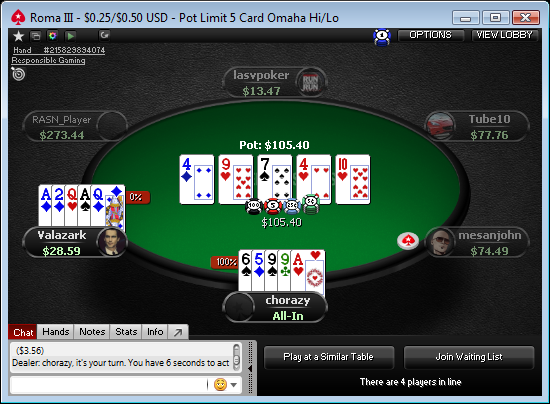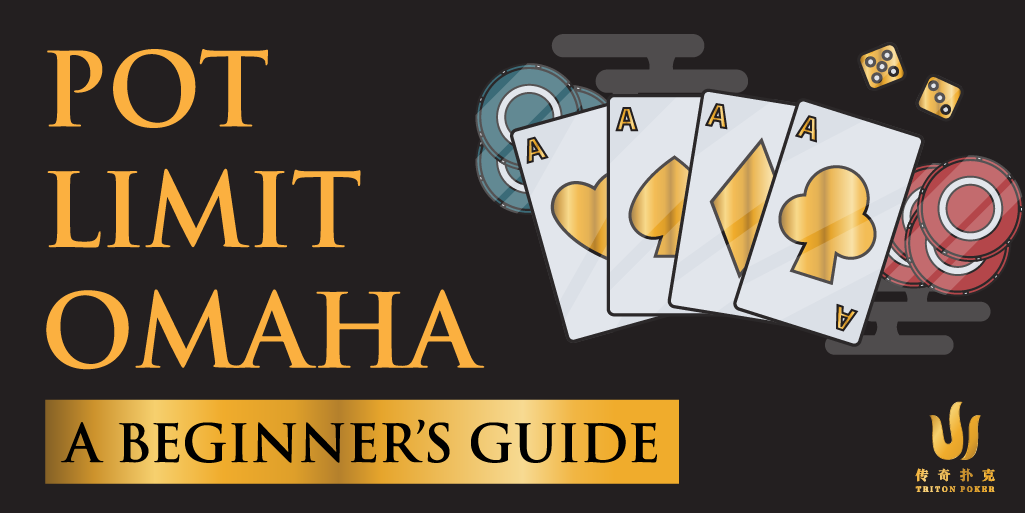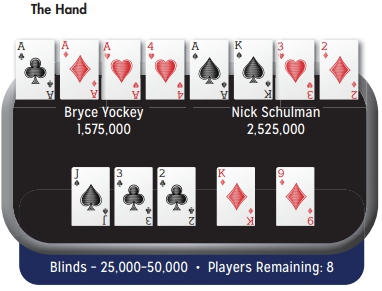Plo Hi Lo Hand Rankings
In Hi/Lo games, there is always an Eight qualifier for the low. In other words, to qualify as a low hand, you must have five different cards ranked Eight or below. Thus 8-7-6-5-4 qualifies as a low hand in Hi/Lo games, whereas 9-4-3-2-A and 4-3-3-2-A do not. The 9-4-3-2-A hand contains only four qualifying low cards (the Nine is disqualified), and the 4-3-3-2-A hand only has four cards of different ranks (pairs. High hand is as we all know (according to the regular hand ranking). Low hand is considered 5 cards 8 or lower (including the Ace) with no pairs. Flushes and straights are not counted. The best low hand is A,2,3,4,5 and the worse low hand is 4,5,6,7,8. I find a very nice explanation about it. You can find it here.
We’re not exactly sure where or when people started playing Omaha Poker, but it was most likely born in home-games as a version of Texas Hold’em. Just like Texas Hold’em, each player is dealt hole cards which are combined with a board of face up community cards. The biggest difference between Omaha and Texas Hold’em is the number of hole cards dealt to each player, but there are a few other important nuances that differentiate between the games. In 1982 Omaha got a solid foundation in Las Vegas Casinos and became a crowd favorite. In just the last few decades, Omaha has become much more widespread and today can be found in most major casinos and big tournaments. Omaha has become especially available in online poker rooms.

Rules for Playing Omaha
Omaha Poker, in its traditional form is not particularly hard to play. Texas Hold’em players will probably find that the many similarities make Omaha one of the easiest games to switch too. A game of Omaha can typically support 9-10 players, and to start the game blinds must be posted. The player to the left of the dealer position (marked by the dealer button) must post the small blind. The player to the left of the small blind then posts the big blind, which is typically worth twice as much as the small blind. Each player is dealt four, face down, hole cards and the first round of betting begins. This is known as the pre-flop round of betting and the players take turns betting clockwise around the table based only on their hole cards.

The pre-flop round of betting starts with the player to the left of the big blind, but all future rounds will start with the player who posted the small blind. Every round of betting proceeds clockwise around the table until each player has either bet as much as every other player, gone all-in, or folded their hand. When every player has met these requirements then the round is over and the hand continues with the flop. The flop consists of the first three community cards that are dealt, face up, in the center of the table. In Omaha, players are required to build their best five-card hand by using exactly two of their hole cards and three of the community cards.
After the flop has been dealt the second round of betting commences. After this round, the fourth community card, the turn card, is dealt and the third round of betting takes place. Finally the river card, the fifth and final community card, is dealt and the last round of betting takes place. After the final bets are made, if more than one player remains in the game, there is a showdown. The remaining players must flip their hole cards to reveal their best 5-card hand. The player with the best hand receives the entire pot, but if there is a tie, then the pot is split evenly among the winners.

Hand Rankings in Omaha Games
The Royal Flush– An ace-high straight of one suit.
Example: A K Q J T
Straight Flush – A straight of one suit.
Example: 6 5 4 3 2
Four of a Kind – Four equally ranked cards.
Example: 8 8 8 8 A
Full House – A hand including a ‘three of a kind’ and a pair.
Example: K K K 6 6
Flush – Five cards from the same suit.
Example: 2 4 A T 6
Straight – Five cards in sequential order.
Example: 7 6 5 4 3
Three of a Kind – Three equally ranked cards.
Example: T T T 6 2
Two Pair – Two different pairs.
Example: 7 7 9 9 A
Pair – Two equally valued cards.
Example: 3 3 5 9 K
High Card – When you do not have any of the above combinations, your hand is ranked by its single best card.
Example: 2 K J 5 7 In this case you would have ‘King High’.
Omaha is often called the game of ‘nuts’ because each player is dealt 4, not two, hole cards making it very likely for multiple straights or flushes to come up in any given hand. With these odds, even if you have a straight or flush early in the hand, it is not unwise to fold on the flop if a better possible combination of cards could exist.
Limit Omaha
Omaha generally has fixed betting limits that work exactly like limits in Texas Hold’em. Omaha limits are displayed as two separate dollar amounts. The first number designates the size of the big blind and the maximum raise allowed in the pre-flop and flop round of betting. The second number tells you the maximum raise allowed in the second two rounds of betting: after the turn and river cards. Let’s look at an example to illustrate how these limits work.
For this example we’ll assume you are sitting at a $4/$8 Omaha table. To start with, the small blind is $2 and the big blind is $4. After the blinds are posted let’s say the player to the left of the big blind decides to ‘call’ and posts his $4 bet. The next player decides to raise but because of the limits, he can only raise $4, so he calls $4 and raises $4. In total this player wagers $8. If the third player wants to raise he can only raise by $4 as well, taking the total bet to $12. In any given betting round there can only be three total raises. After the flop the limits are the same, but after the turn the bet limit increases to $8, and remains there for the river as well. These limits are important for keeping the game under control and preventing the volatility that you see in a no-limit Texas Hold’em game. In fact, you will rarely see no-limit Omaha games offered anywhere.
How to Play Pot Limit Omaha (PLO)
Pot limit Omaha, often simply referred to as PLO, follows the same structure as standard limit Omaha, but the betting limits are determined by the size of the pot. When raising in a PLO game, the size of your raise cannot exceed the size of the pot. To calculate the size of the pot you must add three different variables:
- The sum of all bets from previous rounds.
- Any previous bets from the current round.
- The size of the bet required to call the current bet.
While this is a far cry from a no-limit game, the pot can grow very quickly in a pot limit game, especially in the later betting rounds. Seeing a PLO hand all the way to the showdown can be very expensive so only the strongest hands should be played. As mentioned earlier, PLO games strongly favor the nuts.
How to Play Omaha Hi Lo
Omaha Hi Lo (also known as Omaha 8) is a very popular variation of the game, but it can offer a very different challenge than a traditional Omaha game. Before we get into the details, know that there are some similarities between a Hi Lo and normal Omaha games. For instance, the betting rounds in an Omaha Hi Lo game can either follow the standard limit rules, or pot limit rules that you see normally in Omaha. Also, you should be aware that if no player can make a five-card hand in which every card is unique and ranked 8 or lower (aces are low) then the hand proceeds as a regular Omaha game. If one or more players can put together exactly two of their hole cards and three of the community cards to form a low hand (cards of rank 8 or lower with no pairs, three of a kinds, or four of a kinds), then things get a bit more interesting.
When one or more players can make put together a low hand, then the game effectively splits into two separate competitions with two separate, equal pots: the low pot and the high pot. In this situation, any five-card hand can compete for the high pot; you need only play as you would for a normal Omaha game using the same rules, hand rankings, and limits. If you want to chase the low pot though, you have to understand how the low winner is determined.
What Is The Best Hand In Omaha Hi Lo
To win the low hand in an Omaha Hi Lo game you need to look at all of the low players’ hands and find the ‘worst hand’. Start by comparing everyone’s highest card. Out of all of these highest cards (eight or below) the lowest wins. If there is a tie, then you look at the tied players’ second highest cards to see whose is lowest. You continue through the cards until you have seen them all. If two or more players have the exact same low hand, then the low pot is equally split between them all. Lets look at an example to see how this works.
Hi Lo Example
| Player | Hole Cards | High Hand | Low Hand |
| John | J T 4 2 | A K Q J T (Straight) | 6 4 3 2 A |
| Mary | 5 4 8 9 | K Q 8 9 6 (King High) | 6 5 4 3 A |
| Steven | K 2 4J | K K 32 J (Pair) | 6 43 2 A |

Community Cards: A K Q 6 3
After all the rounds of betting, three players remain in a hand of Omaha Hi Lo and it’s time for the showdown: John, Mary, and Steven. The table above represents the high and low hands these players, and there is $1000 in the pot. Lets start by looking at the high hands. Johns straight beats Mary’s three of a kind and Steven’s pair so John wins the high pot worth $500.
Plo Hi Lo Hand Rankings Week 9
When we look at the low hands, we see that each player’s highest card is a six, so we need to look at the second highest cards. John has the 4 and Steven ties him with the 4 but Mary’s 5 knocks her out of the low pot. After this point it is clear that Steven and John have the same low hands and must split the low pot. Each will receive $250, and since John won the high pot, he will be walking away with $750 in total.
More Hi Lo Info
To win the low pot, the best hand is 5432A (known as the “wheel”) because these are the five lowest non-duplicate cards you can hold. The worst low hand you can hold is 87654 because the cards are the highest 5 non-duplicating cards that do not exceed eight. In some games, the low hands can contain cards ranked as high as nine, and conversely sometimes seven is used as the cut of point.
Plo Hand Rankings
Although rare it is possible to win both the high pot and the low pot (known as a “scoop”). The wheel (5432A) is one of the famous hands that can accomplish this, but you can also make two separate hands: one for the high pot and one for the low pot. Imagine this situation.
- Community Cards: 5 J 2 Q A
- Hole cards are 3 T 4 K.
With these cards, you can put together two different hands: A K Q J T (a royal flush) for the high pot and 5 4 3 2 A (the wheel) for the low pot. These hands cannot be beaten, and at worse you will have to split a pot.